AOF is not just creating a game, but building a complete Web3 esports ecosystem.
Author: Deep Tide TechFlow
Currently, as the competition in the Meme and AI sectors intensifies, the returns from finding projects are continuously declining.
Recently, the shift of funds from Solana to Base in search of new AI projects is a very clear signal: where the firelight does not reach, hidden gold lies.
You should pay attention to opportunities in the less spotlighted sectors when the crowd is clamoring.
If we turn our gaze to Ethereum, we can see that the recent rise in ETH prices has led to a general increase in the ecosystem, with the L2 ecosystem regaining funding and attention;
At the same time, the gaming sector, after a long period of silence, is in urgent need of change.
Elon Musk even expressed a desire to "make gaming great again," although this statement is not about Web3 games, it reflects the collective yearning of investors and players in the entire gaming sector.
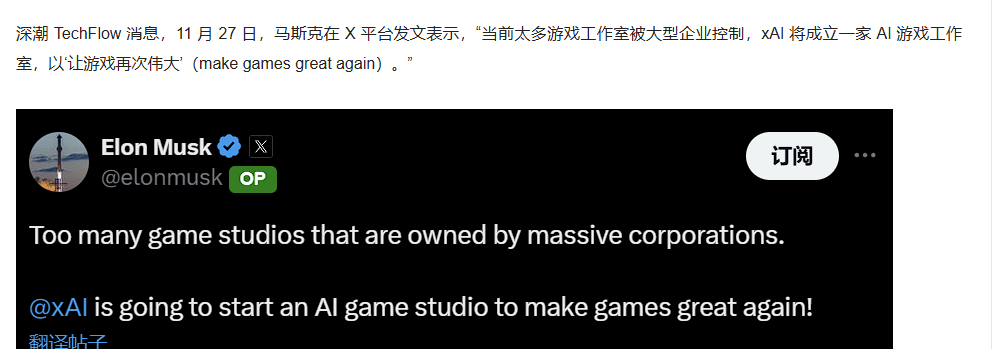
The current issues with Web3 games are clear and often discussed --- the prevalence of "scam" token economic models, "predators" undermining fairness, and studios exploiting the system, making it difficult for genuine players; at the same time, the economic model of a single game is hard to sustain, lacking an effective value circulation system…
Continuing with the logic of finding opportunities in the shadows, one of the L2s in the Ethereum ecosystem, Metis, seems to be rarely mentioned, but its performance is excellent and can fully support game operations; meanwhile, the ecosystem is relatively blank, making the benchmark effect more valuable.
Thus, a game built on Metis, dedicated to solving the above historical issues, is more likely to have the first-mover advantage for early investors.
This leads us to the main subject of this issue --- Arena of Faith, a game that started as a MOBA but is actively expanding its game matrix and new gameplay.
After trying out this game and understanding its related ecosystem, I believe it has shed the historical burdens of previous Web3 games and is attempting to break the collective curse of the entire sector's death spiral.
A brief version could be:
Deflationary token design, ensuring every token "has value and is put to good use."
Innovative POFS frame generation proof technology, making fair gaming no longer just a slogan and leaving no room for cheating.
Game matrix layout, a shared economic system, and intercommunication of multiple in-game token assets, forming a value cycle.
Focusing on long-tail esports, exploring value territories that giants have not ventured into.
If you are interested in these value points and still pay attention to Web3 games, feel free to click the battle preparation button and embark on a journey of interpretation.
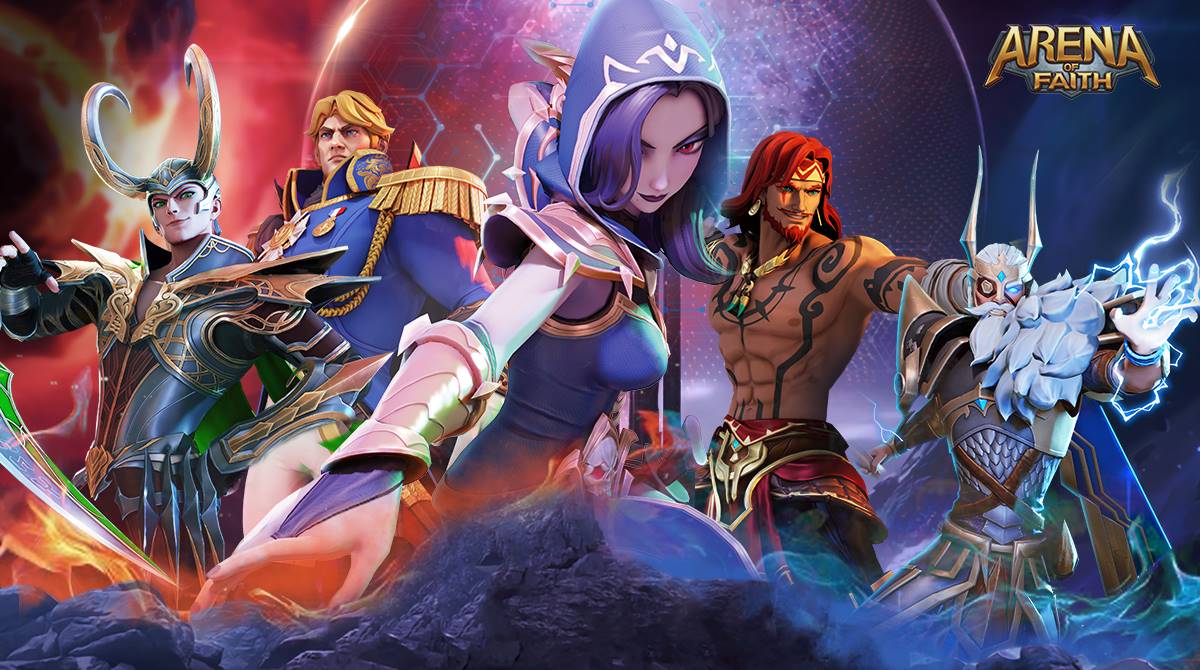
Originating from classic MOBA, expanding the game matrix
During the initial playthrough of Arena of Faith (hereafter referred to as AOF), we experienced a familiar yet unfamiliar sensation.
Familiar, because the game is a MOBA type that almost all players have encountered; and unfamiliar, because it is not just a single MOBA, but a multi-game matrix that is interconnected and influences each other.
First, let's start with AOF's MOBA gameplay.
The traditional 5v5 battle mode is the core gameplay of AOF, where players need to push through defensive towers on three lanes to ultimately destroy the opponent's main base.
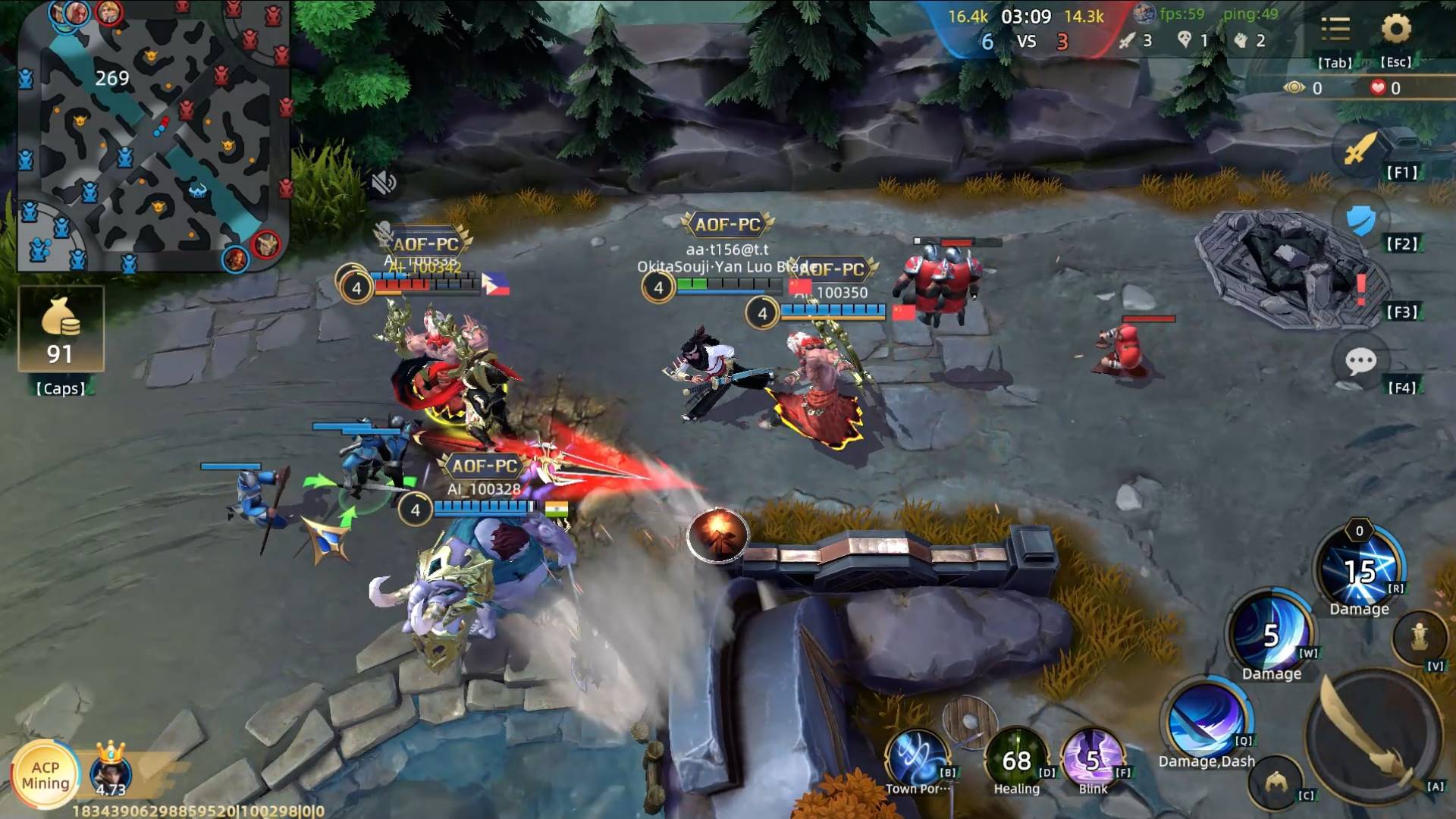
This gameplay has stood the test of time and has been validated by the market.
As one of the most successful game types globally, MOBA has over 500 million users. AOF can draw on over a decade of game design experience from DOTA2 and LOL, while also relying on the existing esports ecosystem. Players' operational habits and tactical thinking can be seamlessly transferred, which significantly reduces the difficulty of promoting the game.
For Web3 games, having a "familiar" aspect similar to other games is the foundation for expanding the user base.
Additionally, in terms of battle rules, AOF has created a unique arena room mechanism that allows players to create or join matches at any time. The entire system uses the popular ELO rating system to ensure that both sides of the match are evenly matched. There is also a seasonal mechanism, with each season lasting 30 days, where players accumulate points by participating in ranked matches to earn seasonal rewards. All match data is recorded on the blockchain to ensure competitive fairness and provide a reliable data foundation for professional esports.
At this point, you might think this has nothing to do with Web3 games; what about the asset design?
In matches, players earn gold by defeating minions and monsters to purchase equipment, level up, and learn skills, which is consistent with traditional MOBAs; however, the game also features an off-game growth system (on-chain): players' hero NFT cards can gain experience through use, and upon leveling up, they receive attribute bonuses. Skin NFTs provide varying degrees of bonus effects based on rarity, all designed to maintain game balance.
This corresponds to the on-chain incentive mechanism, meaning that playing and earning in the game are separated.
Regular players can fully experience the core gameplay for free, while economic incentives mainly come from the competitive system: victories in arena rooms can earn ACP tokens as rewards, with the daily reward pool dynamically adjusted based on overall network activity.
Additionally, after the ranked season ends, NFT rewards are distributed based on player ranks; major tournaments feature substantial prize pools, funded by sponsors and ticket sales, with rewards also being on-chain tokens.
Considering that Web3 games need to expand their user base, AOF is equipped with a globally unified server architecture, supporting cross-platform battles, and uses an AI system to help newcomers quickly get started, ensuring that players from any global region can compete without lag, thus lowering the learning threshold.
It is worth mentioning that unlike many chain games that overly emphasize economic aspects while neglecting game refinement, AOF has independently developed a mobile graphics rendering engine that supports real-time lighting and soft shadow effects, employs multi-layer texture blending technology to enhance visual quality, and optimizes performance through ambient occlusion (AO). This system allows AOF to run smoothly on mid-range phones while maintaining high visual quality.

However, this is ultimately just a MOBA game, and its lifecycle and potential user attraction remain limited; examples of achieving success solely through one game are rare in Web3 gaming.
AOF has clearly learned from previous projects' experiences, and beyond its own MOBA game, is actively expanding a matrix of multiple games to maximize the value of the same IP and corresponding on-chain assets.
Currently, based on AOF, the project has released other games including:
- Action PVP game (Arena of Ancient Warrior): A 1v1 fighting game planned for release in Q1 2025, combining a Street Fighter-style combo system with a unique on-chain ranking mechanism. The game will support cross-platform battles and reuse AOF's hero characters, allowing players' NFT assets to gain new usage scenarios.
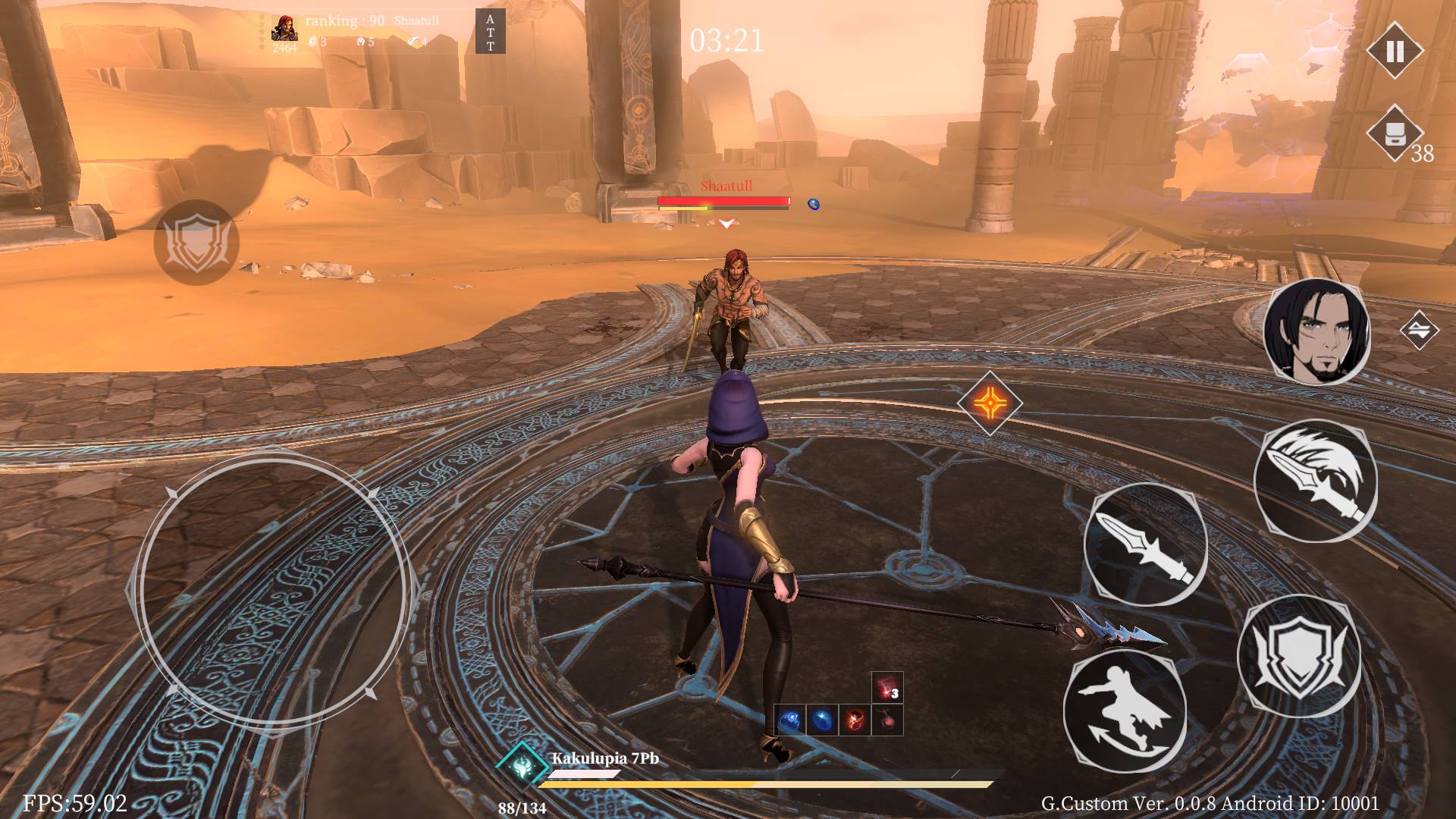
2. ARPG PVP game (Arena of Dungeon Challengers): An innovative product combining Roguelike gameplay with PVP competition, expected to be released in Q3 2025. The game will utilize AOF's skin system.
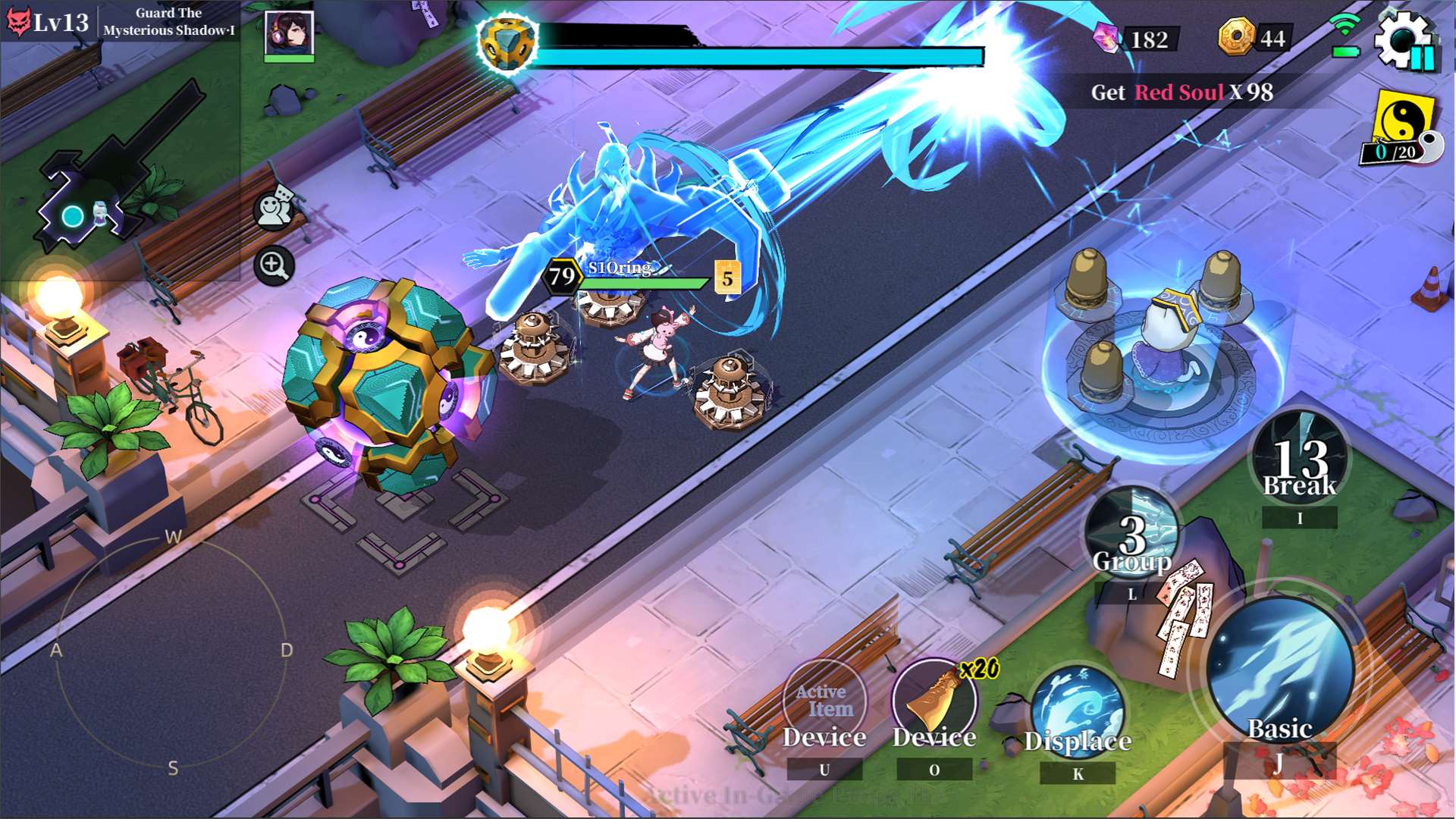
3. VR competitive product line: Two VR fighting games targeting the metaverse, planned to be launched in collaboration with well-known VR hardware manufacturers. They will integrate with AOF's NFT system, allowing players' digital assets to be showcased in the VR world.
- Mini-program support: A TG bot service developed for light users and to enhance community interaction, providing real-time match data queries, performance statistics, equipment recommendations, and more.
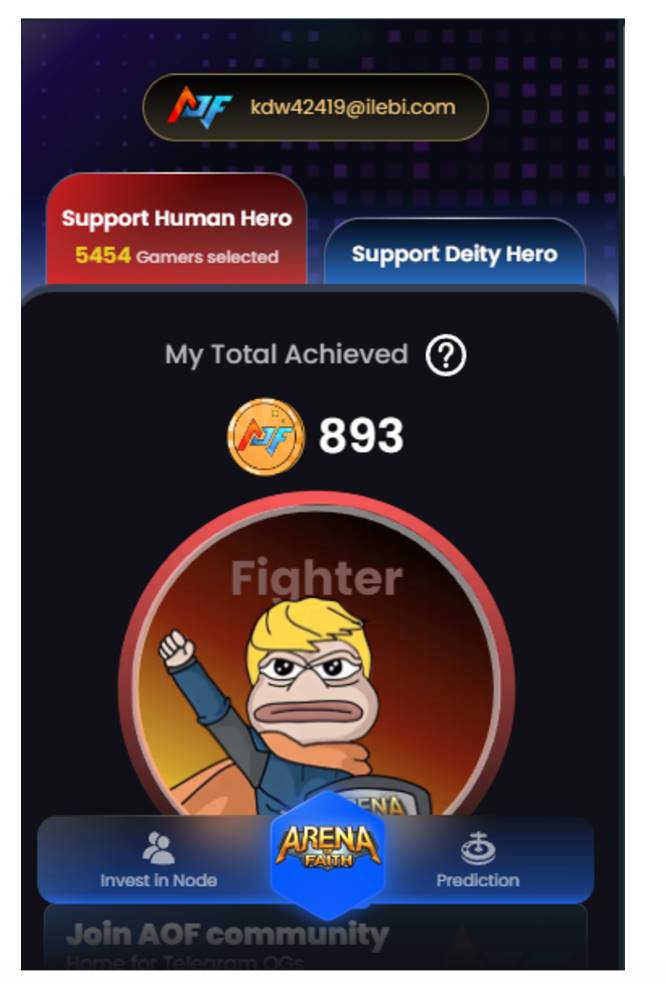
What benefits does a matrix of multiple games bring to on-chain assets?
AOF's approach is to allow on-chain assets to form cross-game interoperability, maximizing the liquidity of assets; at the same time, sharing a single IP in game content creates synergy, thereby establishing a larger game economic system that facilitates smooth internal circulation of assets.
First, from the perspective of unified IP image design, all game products share the same worldview system, with hero character settings and images maintaining a high degree of consistency. Each new work expands the depth of the worldview, increasing the cultural value of the IP.
Secondly, since the important rights in AOF games rely on the NFT series, it is technically not difficult to apply NFTs from a single game across multiple games; thus, using NFTs in all games within the game matrix can greatly enhance the practical value of NFTs, and more usage scenarios mean more empowerment.
Finally, the ACP token serves as a unified settlement currency, circulating across all games. Economic activities in different games, such as NFT trading, tournament rewards, and item purchases, are all settled using ACP.
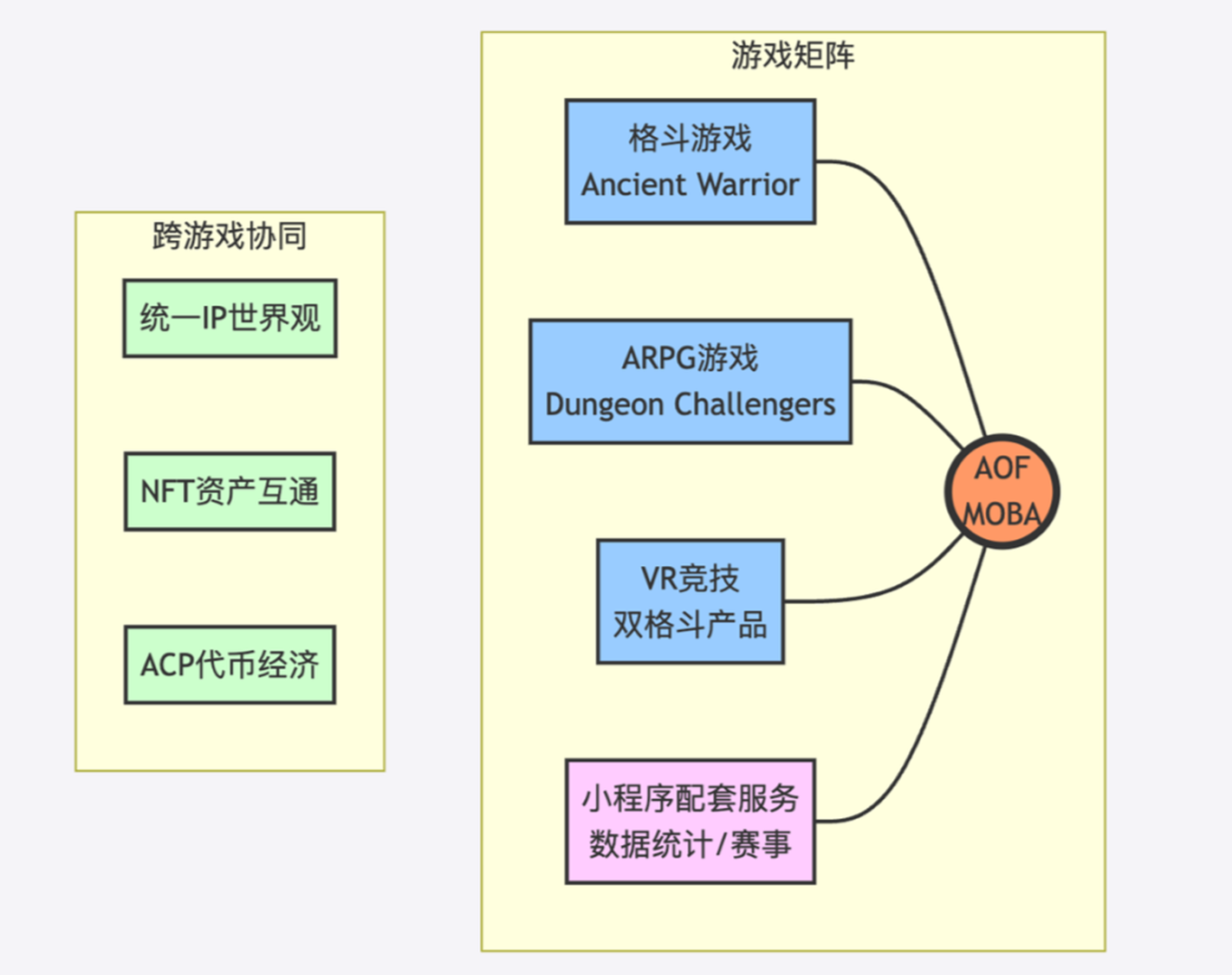
We will provide more details about the ACP token in the token economy section later.
It is evident that a single game is merely the foundation of a matrix; what AOF aims to do is clearly more about being a platform and ecosystem.
However, every beginning is difficult. Does AOF itself have a sufficient user base? Perhaps we can find the answer from recent data.
In terms of user acquisition and retention, public data shows that the game has currently accumulated over 250,000 active users, covering PC, Android, and iOS platforms. User distribution spans multiple regions globally, with the Asia-Pacific region accounting for 45%, Europe and America for 35%, and other regions for 20%. The average daily new user count is nearly 1,000, with user retention rates above the industry average.
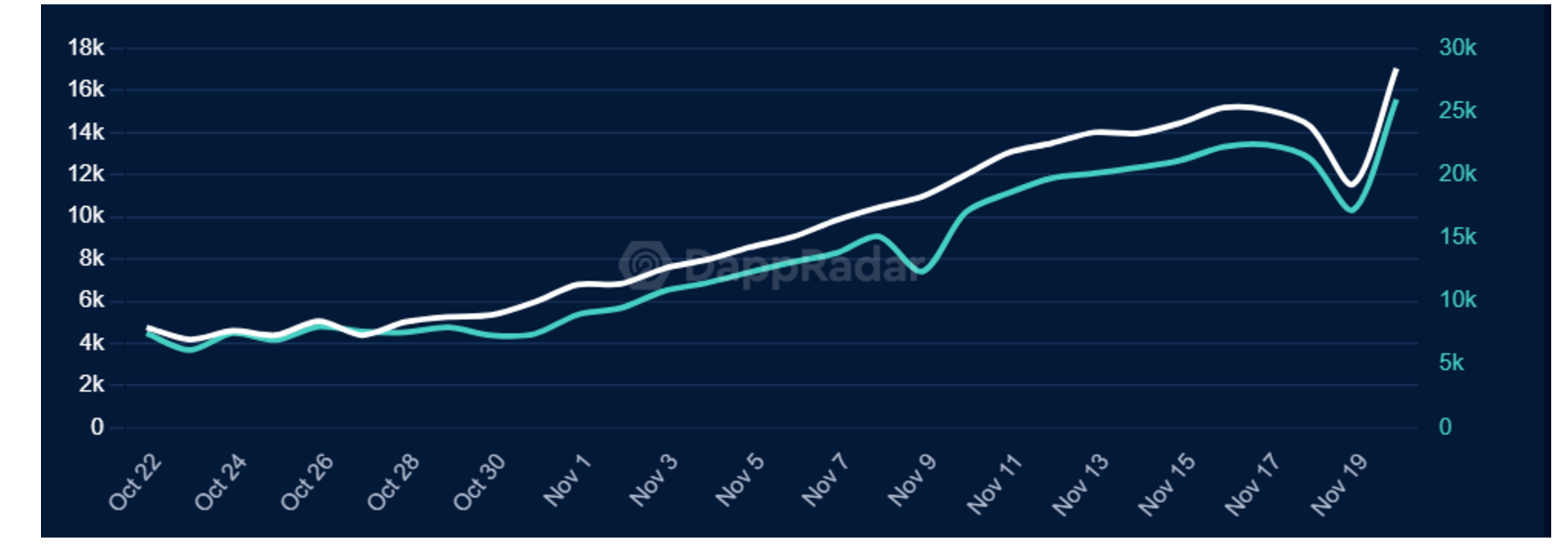
In terms of on-chain metrics, AOF's daily active wallets (UAW) remain stable at around 5,350, with an average of 28,790 on-chain transactions per day and a daily transaction volume of approximately $185,000. These figures perform excellently in the current environment where chain games are not particularly popular.
It is noteworthy that, due to the game's use of Immutable (IMX) login components and related technologies, AOF has complete contract deployments on both the IMX and Metis chains. The former has launched an on-chain sign-in system and a guessing system, which can be understood as on-chain proof of game operation activities; while the latter has deployed the game's testnet data and corresponding node system.
Beyond technology, AOF's financing background is also significant.
Web3 gaming giant Animoca Brands led the Series A round with an investment of $8 million; Immutable and Metis participated as strategic investors in the Series B financing, providing technical and ecological support for the project; the world's largest gaming guild, YGG, also made a strategic investment in the early stages.
At the same time, AOF has established a deep strategic partnership with Metis, including receiving $1 million in funding from the ecological fund, direct access to Metis's marketing resources and technical team, and participation in Metis's early project incubation program. These collaborations not only provide financial support but, more importantly, offer complete ecological resource integration.
In the relatively less competitive Metis ecosystem, the value brought by a benchmark project may far exceed that of other ecosystems where projects are clustered together.
In summary, we can see that AOF currently has a solid gaming foundation, a complete game matrix, and significant market performance and endorsements, which are the basic elements for a game to rise to prominence.
POFS On-Chain Verification, Renewing Fairness
However, relying solely on these factors does not seem to fully resolve the long-standing curse of chain games and esports: too many cheaters and non-gaming exploiters flooding in, leading to the extinction of the game ecosystem.
Right now, we indeed need a good game, but we need even more a foundation and technology that can maintain a healthy gaming environment.
This is another value-added point that AOF provides.
Why are you not interested in Web3 games? My answer might be:
First, frequent cheating, with many players using scripts and bots for automated gold farming, diluting the earnings of ordinary players; second, the low-frequency confirmation mechanism of traditional blockchains makes it difficult to verify gaming behavior in real-time, preventing the immediate identification of cheaters.
In response to this common issue, AOF offers the solution of POFS (Proof of Framesync), which is frame generation proof.
To put it simply, it divides game logic into fixed frames, uploading player behavior data within those fixed frames to detect any cheating behavior.
Whether you played or not, it is clear under this POFS mechanism.
At the same time, the POFS mechanism naturally requires AOF to design its own network for verification and post-event tracing:
Decentralized nodes verify each frame's operations in real-time, allowing any observer to participate as a verification node, ensuring complete transparency in the gaming process; all operational data is stored on-chain, supporting replay verification and providing an immutable historical record for matches.

This resembles a PoS-based network, using technical means (POFS) to verify whether cheating occurs in the game.
- By verifying the compliance of each frame's operation trajectory with game rules, it can theoretically detect abnormal behavior with millisecond-level granularity, ensuring that tokens are not unfairly distributed or hacked.
Currently, obtaining tokens in the game must be done by carrying hero card NFTs, with gameplay data uploaded on-chain, and verification nodes confirming whether the users participating in the game meet the standards (basic game data, idling behavior will inevitably fail to meet the standards).
Users who do not meet the standards cannot produce tokens. Therefore, exploitative behaviors in worthless games can be effectively avoided.
Currently, AOF is using this mechanism in its game, but if it could be opened up in the form of an SDK, it would provide a standard solution for competitive games across the entire gaming sector, reshaping the standards of fairness in Web3 games.
Token Deflationary Art: Tokens Used Wisely, Tokens Have Value
If cheating methods can be solved through technology, how should we address the common ailment of the "death spiral" in Web3 games?
We have seen too many games that overly rely on a single mining gameplay lacking real demand scenarios, leading to token supply far exceeding demand, ultimately resulting in a price crash and ecosystem collapse.
AOF's breakthrough lies in designing a naturally deflationary mechanism driven by multiple scenarios, ensuring that every participant has a clear demand for the ACP token.
From game charging, node staking to event tickets, every participant in the gaming ecosystem, regardless of their motivation, has multiple dimensions of token consumption that ensure "tokens are used wisely," thereby achieving "tokens have value."
Generally speaking, if you participate in a Web3 game, your identity typically falls into one of the following categories: heavy players (exploiters can also be considered from an investment perspective), light participants (benefiting through assets or staking mechanisms), and organizations or individuals hosting various activities or marketing around the game itself.
Let’s look at how AOF ensures tokens are used wisely from these three motivations.
- Heavy Players: Gaming as Mining (PoW):
As mentioned earlier, AOF players need to purchase hero NFTs to participate in matches to experience the entire process of earning tokens.
Thus, NFTs essentially become the mining machines for token production, and players operate these machines in matches, achieving victory through skill, resembling a proof-of-work in game rules; you complete the game and achieve victory, and the system recognizes your work and rewards you accordingly.
In short, gaming is mining.
Under this main logic of play, to avoid infinite inflation caused by continuous gold farming, NFTs are designed with a 30-day charging cycle. Players need to periodically recharge their NFTs to maintain mining efficiency, with each recharge consuming tokens. At the same time, to pursue higher returns, players will invest tokens into skin synthesis and upgrade systems, as having better skins and higher-level NFT heroes will yield higher gold farming efficiency.
For players, as long as you engage in gameplay, there will definitely be the following token consumption paths:
NFT charging: consumes ACP tokens every 30 days, with the amount adjusted dynamically based on game popularity.
Skin synthesis: ACP tokens are invested, and the portion used for synthesis is permanently destroyed.
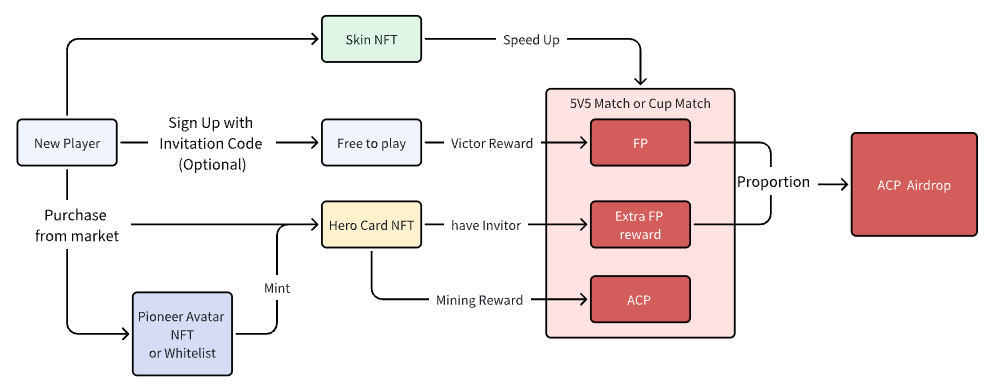
- Validators: Co-builders of Game Fairness (PoS):
The fairness and outcomes of AOF's events require decentralized data verification, which necessitates establishing a credible network of verification nodes around the previously mentioned POFS (frame generation proof).
Designing a decentralized validator network around an anti-cheating mechanism effectively provides profit opportunities for light participants in the gaming ecosystem.
What you can do is stake tokens to become a verification node. For the game itself, participants' staking ensures data authenticity; for your own interests, staking can also yield staking rewards, achieving an organic combination of POFS and staking mechanisms.
Node operators who absorb your staked tokens can earn basic income through staking and additional rewards by verifying event data. AOF has designed a linear release mechanism to ensure the long-term stability of nodes while creating a deflationary effect through token locking.
The inevitable token consumption paths here are:
Node staking: long-term locking.
Penalty mechanism: malicious behavior leads to token destruction.
Transaction fees: a portion is permanently destroyed.
- Event Organizers: Hosting Esports, ACP as a Value Bridge
As an esports game, AOF requires continuous event operations to maintain ecological vitality. Event organizers bring traffic and attention to the game by hosting competitions, while the game provides a sustainable business model for events through its token economy.
Organizers can issue event passes to generate income while establishing prize pools to incentivize quality events and player participation. A portion of the ticket revenue is used for ACP token buybacks and destruction, converting esports popularity into deflationary momentum.
The inevitable token consumption paths here are:
Event registration: consumes ACP tokens, with the consumed portion permanently destroyed.
Ticket revenue: used for ACP token buybacks, meaning buyback destruction.
Event deposits: temporarily locks ACP tokens, which can be understood as a deposit for hosting events.

If we look at the three roles together, AOF has clearly designed a multi-layered token deflationary closed loop. Through the daily consumption of heavy players, the continuous locking of verification nodes, and the buyback destruction from event operations, AOF creates short-term, mid-term, and long-term multi-layered deflationary pressure on ACP. This multi-dimensional deflationary design ensures that the token's value is effectively supported across different time periods. As the player base expands, the number of verification nodes increases, and the scale of events grows, the token demand from these three roles will increase simultaneously. This increase in demand will create deflationary pressure, which in turn supports the token's value, attracting more participants to join the ecosystem and forming a virtuous cycle.
Grasping the "Long Tail of Esports," Seizing Unique Ecological Positions
The design of using esports events to consume tokens mentioned above is good, but do we need to take this step to host esports events now?
In fact, this involves a structural issue in the gaming industry --- long-tail esports events are still in a demand vacuum.
People may understand esports events like the LOL World Championship and CS:GO Major, but in reality, these are events at the top of the pyramid. Major events are monopolized by leading organizations, making it difficult for small event organizers to obtain resource support, resulting in an overly sharp "pyramid" structure in the esports ecosystem.
In the unseen areas, grassroots competitions actually have a large long-tail demand, but due to the lack of stable business models and revenue sources for small events, they cannot be sustained smoothly.
The logic of Web3 has always been to disrupt from the margins, making grasping the long tail of esports a new breakthrough point.
For example, as introduced earlier, it is essentially a decentralized event organization mechanism for esports, where any user holding an AOF verification node can become an event organizer. Smart contracts automatically handle core aspects such as registration and prize distribution, significantly reducing event operation costs.
At the same time, event revenue is recorded on-chain in real-time, with prize pools automatically distributed and tips directly credited, ensuring transparency and efficiency in fund circulation.
Regarding cheating and fairness issues, the POFS technology can achieve real-time verification and permanent storage of event data, providing a reliable technical foundation for esports competitions.
Although currently, AOF is the only one promoting such an esports platform, a logically coherent and fully functional event framework has the potential to expand outward and unlock the value of long-tail demand.
I believe that with proper operation and promotion, AOF's event hosting infrastructure has at least two noteworthy value points:
First, event operation dimensionality reduction. It provides a one-stop event hosting tool, including registration systems, schedule management, data analysis, etc., allowing grassroots events to enjoy a professional-level operational experience.
Second, community economy activation. By implementing mechanisms such as ticket revenue sharing, digital merchandise creation, and event commentary incentives, it builds diversified income sources to achieve sustainable development of the event ecosystem.
ACP Token Release and Airdrop Rewards
This concludes the introduction to AOF. But for pragmatic Web3 players, what project opportunities can you focus on right now?
First, participating in staking is certainly a cost-effective choice.
According to the project's official data in the early stages, over $1 million worth of Metis is currently being staked; participating in staking can yield dual rewards of Metis + ACP, the latter of which corresponds to more value expectations after the mainnet launch.

However, the staking activity has now concluded. Public data shows that this staking event attracted a total of 5,500 users, with around 21K Metis being staked, generating a total of 200,000 ACP rewards, reflecting the players' high participation enthusiasm.
Secondly, if you missed the staking, there are still related airdrop activities based on the expectations of the ACP token release.
According to the official announcement from AOF, the project token ACP will have its Token Generation Event (TGE) and listing in January. This also means the beginning of a new round of gameplay, with more operations possible around the token itself.
To coincide with the token release, AOF will launch a 14-day "Airdrop Tournament" in the previously mentioned MOBA game Arena of Faith on January 6, with a total prize pool of 5 million $ACP.
**The way to obtain these *ACP* is very simple: just participate in playing Arena of Faith.**
The game has designed a season pass system similar to traditional MOBA games, where players need to complete matches to earn corresponding points, leveling up every 100 points, and upon reaching the corresponding level, they can claim the rewards associated with that level.
These rewards include but are not limited to:
FP: Faith Points, which can be exchanged for the official token ACP at the time of TGE;
ACP: the project token, which can be used to synthesize skins or purchase event tickets, unlocking more gameplay;
Different levels of ACP chests: opening these chests can randomly drop ACP, with drop probabilities and quantities varying by chest level.
Season chests: these contain fragments of skins of different levels. Skin fragments can be used to synthesize hero skin NFTs.
It is worth mentioning that if you hold NFTs in the game, such as the game avatars or hero cards mentioned earlier, you can also **stake these NFTs to earn more **excess rewards:
With the same gameplay progress, staking NFTs will correspond to different levels of VIP status, enjoying benefits such as accelerated upgrades, increased rewards for each level of the pass, and reduced resource consumption in matches.
For players looking to engage deeply in the game, holding and staking NFTs may be a more efficient way to earn rewards; while for casual players, rewards can still be obtained in normal matches. It is evident that the threshold for earning in AOF is not high, and the excellent match experience is also worth a try for players.
Overall, through AOF, we can see that the project is not just creating a game but building a complete Web3 esports ecosystem. Through POFS technology infrastructure, a deflationary token economy, and a decentralized event system, it provides a sustainable development paradigm for the entire industry.
For the project itself, a unified token economy and NFT rights system have achieved value interoperability among multiple games. This innovation not only enhances the utility value of players' assets but also brings stronger network effects to the entire ecosystem.
In the future, targeting the long-tail esports market, AOF offers a complete solution. From technical support to economic incentives, from event operations to data rights confirmation, it opens up a new path for the development of Web3 esports.
Everything is no longer as simple as just a game, and we look forward to the project carving out a unique development path.
免责声明:本文章仅代表作者个人观点,不代表本平台的立场和观点。本文章仅供信息分享,不构成对任何人的任何投资建议。用户与作者之间的任何争议,与本平台无关。如网页中刊载的文章或图片涉及侵权,请提供相关的权利证明和身份证明发送邮件到support@aicoin.com,本平台相关工作人员将会进行核查。




